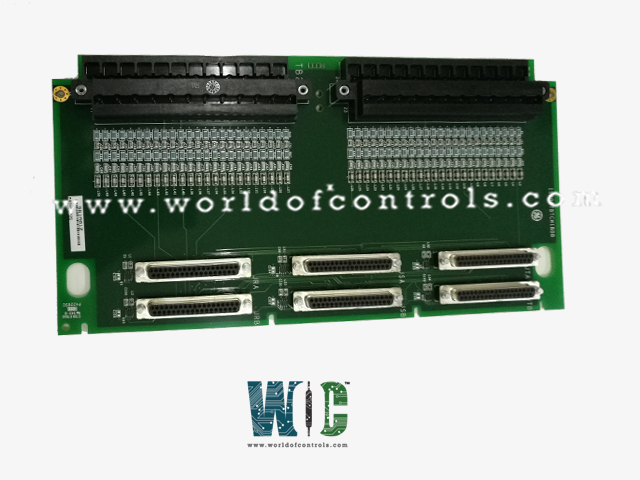
World Of Controls understands the criticality of your requirement and works towards reducing the lead time as much as possible.
IS230TBTCH1C - Thermocouple Terminal Board is available in stock which ships the same day.
IS230TBTCH1C - Thermocouple Terminal Board comes in UNUSED as well as REBUILT condition.
To avail our best deals for IS230TBTCH1C - Thermocouple Terminal Board, contact us and we will get back to you within 24 hours.
SPECIFICATIONS:
Part Number: IS230TBTCH1C
Manufacturer: General Electric
Series: Mark VIe
Product Type: Thermocouple Terminal Board
Number of Channels: 24
Power supply voltage: 28 V dc
Voltage Range: 14 to 32 V dc
Mounting: DIN-rail mounting
Technology: Surface mount
Operating temperature: -30 to 65°C
Size: 33.02 cm high x 10.16 cm
Repair: 3-7 Day
Availability: In Stock
Country of Origin: United States
Manual: GEH-6421H
FUNCTIONAL DESCRIPTION:
IS230TBTCH1C is a Thermocouple Terminal Board manufactured and designed by General Electric as part of the Mark VIe Series used in GE Distributed Control Systems. The thermocouple terminal board TBTC accepts 24 type E, J, K, S, or T thermocouple inputs. These inputs are wired to two barrier-type blocks on the terminal board. Communication with the I/O processor is through D-type connectors. In the Mark VIe system, the PTCC I/O pack works with the TBTC board. Simplex, dual, and TMR systems are supported. In simplex systems, two PTCC packs plug into the TBTCH1C for a total of 24 inputs. With the TBTCH1B one, two, or three PTCC packs plug-in supporting a variety of system configurations, only 12 inputs are available.
INSTALLATION:
Thermocouples are wired directly to two I/O terminal blocks. These removable blocks are mounted on the terminal board and held down with two screws. Each block has 24 terminals accepting up to #12 AWG wires. A shield terminal strip attached to the chassis ground is located on the left side of each terminal block. Mark VIe systems have I/O packs that plug into the board J-type connectors. The number of cables or I/O packs depends on the level of redundancy required.
OPERATION:
The 24 thermocouple inputs can be grounded or ungrounded. They can be located up to 300 m (984 ft) from the turbine control panel with a maximum two-way cable resistance of 450. High-frequency noise suppression and two cold junction reference devices are mounted on TBTC as shown in the following figure. The analog to digital conversion is in the I/O processor, as well as the linearization for individual thermocouple types. In simplex systems using TBTCH1C, one VTCC is used in Mark VI systems. For Mark VIe systems, two PTCC packs are plugged into the board to obtain 24 thermocouple inputs. For TMR systems using TBTCH1B, the thermocouple signals fan out to three J- connectors that either cable to or connect to, the I/O processors. The Mark VI system accommodates 24 inputs, the Mark VIe system accommodates 12 inputs.
COLD JUNCTIONS:
The CJ signals go into signal space and are available for monitoring. Normally the average of the two is used. Acceptable limits are configured, and if a CJ goes outside the limit, a logic signal is set. A 1° F error in the CJ compensation will cause a 1° F error in the thermocouple reading. Hardcoded limits are set at -40 to 85 ° C, and if a CJ goes outside these, it is regarded as faulted. Most CJ failures are open or short-circuit. If the CJ is declared faulty, the backup value is used, which can be derived from CJ readings on other terminal boards, or can be the configured default value.
WOC has the largest stock of OEM replacement parts for GE Distributed Control Systems. We can also repair your faulty boards and supply unused and rebuilt boards backed up with a warranty. Our team of experts is available round the clock to support your OEM needs. Our team of experts at WOC is happy to assist you with any of your automation requirements. For pricing and availability on parts and repairs, kindly contact our team by phone or email.
How does a thermocouple terminal board work?
The terminal board acts as an intermediary between thermocouples and data acquisition systems or controllers. It typically features connectors for thermocouple wires and output terminals that lead to the measurement device. The board ensures proper polarity and maintains the integrity of the thermocouple signals.
What are the types of thermocouples that can be connected to a terminal board?
Thermocouple terminal boards can support various types of thermocouples, including Type J, K, T, E, N, R, S, and B. The specific types supported depend on the design and specifications of the terminal board.
Why is proper polarity important when connecting thermocouples?
Thermocouples generate a voltage signal based on the temperature difference between the measurement junction and the reference junction. Proper polarity ensures accurate temperature readings. Reversing the polarity can lead to incorrect temperature measurements.